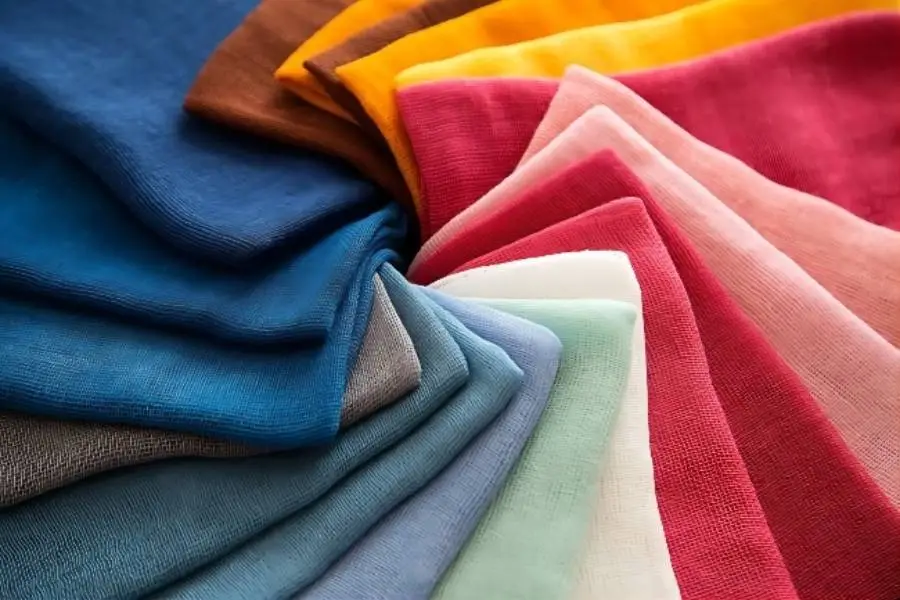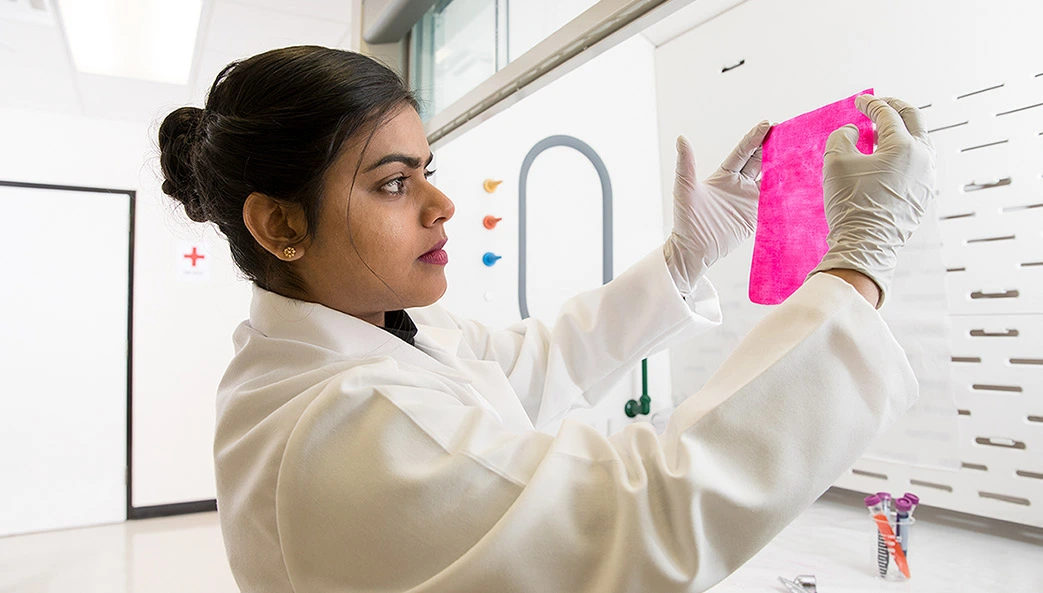Influence of conventional finishing on fabric color Post-finishing is the last process of the…
Eco-friendly fabric dyeing technology
Table of Contents
- Green Dyeing and Finishing Process in Textiles
- Low temperature dyeing technology
- Water Recycling Systems
- Microwave assisted technology
- Dye Selection and Fixing Technology
- Green Dyeing Auxiliaries
- New dyeing and finishing technology
- Plasma technology
- Cold rolling pile dyeing process
- Radiant energy technology
- Knitted fabric flat width cold rolled pile dyeing technology
- Small bath ratio dyeing technology
- ChiuVention InfraDye Infrared Lab Dyeing Machine advantages
- Foam Dyeing Technology
- Plant dyeing
- Waste dyeing
- Microbial colouring
Green Dyeing and Finishing Process in Textiles
Green dyeing and finishing is a sustainable textile process. It uses eco-friendly and energy-saving methods. The goal is to reduce or eliminate harm to the environment and human health.
With the rise of green issues, interest in green dyeing and finishing has grown. The green dyeing and finishing process reduces environmental impact and resource use. It does this by innovating in dye selection, water use, energy, and waste treatment. It also includes research on green printing and dyeing aids.
Low temperature dyeing technology
Low-temperature dyeing technology in green processes uses a lower dyeing temperature. It dyes fibres while cutting energy use and pollution.
New dyes and green printing and dyeing aids can improve low-temp dyeing of fibres. The green auxiliaries boost the dyeing effect. They enhance the affinity between fuel adsorption and fibres. The dye carrier can effectively fix the dye on the fibre to avoid the waste and release of dye.

Low-temperature dyeing technology can effectively reduce energy consumption and greenhouse gas sweating. At the same time, this tech can reduce dyeing’s thermal damage to fibres. It can also improve dyeing uniformity and colour fastness in a low-temp dyeing process. This will enhance product quality.
Water Recycling Systems
The water recycling system saves water and protects the environment. It does this by recycling and purifying the waste water from dyeing and finishing. In dyeing and finishing, manufacturers can use purified water in various ways. It can mix dye slurry, wash and rinse dyeing tanks, and rinse fabrics. This reduces the demand for fresh water. It also cuts waste water and recycles water resources.
However, in waterproofing fabrics, it is best to avoid using reused water from printing and dyeing. Printing and dyeing reuse water has a high pH and hardness. It may have residual impurities, such as dyestuffs and electrolytes. These can harm the stability of the fabric waterproofing agent’s working solution. As a result, the processed fabrics may develop waterproof spotting issues. If, due to production needs, waterproof finishing must use printing and dyeing water, you can try a non-ionic carbon six waterproofing agent. It is a better choice than conventional ones. It is more stable and resistant to anionic interference.
Microwave assisted technology
Microwave-assisted technology uses microwaves to enhance and speed up dyeing. This reduces its environmental impact.
Microwave-assisted dyeing is faster than traditional water bath methods. It heats the water molecules in the fibre. This helps them enter the fibre more efficiently, boosting productivity.
Secondly, microwave-assisted technology can improve the dyeing uniformity. Microwave heating is very selective. It can locally heat fibre materials. This makes the dye distribute more evenly in the fibre. This uniformity improves dyeing quality. It also reduces dye use and costs.
Dye Selection and Fixing Technology
Dye selection is a crucial part of the green dyeing process. Traditional dyes often contain heavy metals and solvents. They harm the environment and human health. So, it is crucial to choose eco-friendly, non-toxic, and safe dyes for green dyeing and finishing. For example, in green dyeing, water-soluble and vegetable dyestuffs are commonly used. They are soluble, low-toxicity, and safe for the environment and humans.
The fixation techniques in green dyeing and finishing are: physical, chemical, and biological. Physical fixation is the fixation of dyestuffs. It results from physical forces, like ion bonding, between the fibre and the dyestuffs. A reaction between the dye and the fibre performs chemical fixation. This includes using reducing dyes and cross-linking agents. Biological fixation is the use of microbes to change or degrade harmful dye residues.
Green Dyeing Auxiliaries
In the green dyeing and finishing process, we use green printing and dyeing auxiliaries to improve dyeing. These include low-toxicity fluorescent whitening agents, bio-based leveling agents, and aldehyde-free color-fixing agents. In the finishing process, we now use more eco-friendly, waterproofing agents. These are carbon six and non-fluorine agents, not long carbon chain ones.
These green printing and dyeing auxiliaries perform well. They have low toxicity and high biodegradability. They are common, eco-friendly additives in green dyeing and finishing.
 New dyeing and finishing technology
New dyeing and finishing technology
New dyeing and finishing technology is key. It aids pre-treatment, dyeing, printing, and post-finishing. Using advanced technology, we can dye and print in many colors and species. In textile finishing, we can achieve effects that ordinary methods cannot.
Some new technologies, using radiation and ultrasound, can modify fibers. They can achieve better results in pre-treatment, dyeing, printing, and finishing. These new technologies can help the printing and dyeing industry.
Plasma technology
Desizing, refining, bleaching, and mercerising in textile dyeing and finishing are all wet processes. They produce a lot of sewage, which causes pollution. In recent years, worries about the environment have grown. This is especially true for water pollution. So, green production is now the goal of textile manufacturing. A new, clean dyeing and finishing method uses plasma technology.
Plasma technology is water- and energy-saving. It causes less pollution. It’s easy to control. It only affects the surface of the fibre in textile processing. It does not destroy its nature. In theory, one can apply it to all textile processing. Plasma technology in textile processing in a wide range of applications:
Used to improve fibre spinnability;
To improve wool against felting shrinkage;
Improvement of fibre hydrophilicity;
Increasing fibre surface bonding;
To improve dyeing properties and increase the depth of dyeing;
To impart water and oil repellency to fibres;
Improving the effect of pre-treatment of natural fibres;
Perform various functional finishes: anti-wrinkle, flame retardant, anti-bacterial, and anti-static. Also, treat the surface to improve dye and finish fixation on fabrics.
In general, plasma has two types: high-temperature and low-temperature. The latter is more widely used in textile dyeing and finishing. Plasma treatment uses dry processing, without water or chemicals. It saves energy and water, reduces waste, and cuts pollution. This helps protect the environment.
Cold rolling pile dyeing process
Cold roll pile dyeing is a new flat dyeing process. It originated in Europe. It has a high solid color rate, good dye fastness, and low pollution. And it saves energy and is easy to maintain. It is also suited for small batch production.
The cold rolled pile dyeing process has drawbacks. It’s hard to control the color and light. Also, we can’t fix defects in the dyeing process in time. Cold rolled pile dyeing is a new process. It is for dyeing cellulose fibers with reactive dyes.
The cold rolled pile dyeing process has two methods: 1. into the cloth → dip in rolled dye → dry → dip in solid colour liquid → roll and stack → wash → soap wash → wash → dry → drop cloth; 2. into the cloth → dip in rolled dye → roll and stack → wash → soap wash → wash → dry → drop cloth.
 This dyeing process has a simple pre-treatment step. It shortens the high-temp three- or two-step methods to a low-temp one- or two-step process. This greatly reduces the process time. It allows for uniform penetration during stacking. Additives and impurities have enough time to act. After washing to a good quality, the fibre is less damaged. It has high permeability and whiteness. This is especially true for spandex elastic fabrics. They won’t wrinkle and will lose less elasticity.
This dyeing process has a simple pre-treatment step. It shortens the high-temp three- or two-step methods to a low-temp one- or two-step process. This greatly reduces the process time. It allows for uniform penetration during stacking. Additives and impurities have enough time to act. After washing to a good quality, the fibre is less damaged. It has high permeability and whiteness. This is especially true for spandex elastic fabrics. They won’t wrinkle and will lose less elasticity.
Radiant energy technology
In recent years, there has been more interest in using lasers in textile dyeing and finishing. This includes: cutting materials, heat treatment, testing, and inspection. It also includes modifying fiber materials, engraving, and controlling dyeing and printing.
UV radiation has a wide range of applications in textile dyeing and finishing. The advantages of treating textiles with UV radiation are:
It has a high energy level and can modify textile materials; it does not need a vacuum or a special gas. They can process it only in atmospheric air.
Ultraviolet (UV) radiation can improve dyeing and printing on fabrics. It boosts dyeing cotton, adsorbing and fixing wool, and dyeing silk with some dyes. Tests showed UV low-temperature dyeing on silk was effective.
On the other hand, UV radiation finishing is a dry process. It needs no catalyst and has a short fixation time. Using the same principle, we can perform other reactions. This can modify the fiber, either fully or locally. Adjusting the intensity of ultraviolet light can also create different levels of graft modification. This will produce a range of colors, from light to dark.
Knitted fabric flat width cold rolled pile dyeing technology
Now, the dyeing of knitted fabrics mostly uses an intermittent method. This process is mature and the equipment is simple. It can complete the whole dyeing on one machine. But, it has a large bath ratio and uses a lot of auxiliaries. The flat width cold rolled pile dyes fabrics with no creases. The cloth is straight, not hairy or wrinkled. This can cut printing and dyeing wastewater treatment costs. It also greatly reduces the use of dyes and chemicals. It can save 60% in water, 50% in energy, and over 20% in costs, compared to the old rope dyeing and printing method.
Small bath ratio dyeing technology
Small bath ratio dyeing technology saves water. It has developed rapidly in recent decades, especially in its equipment. In dyeing and finishing, which uses impregnation, factories prefer a low bath ratio in the equipment.
The ChiuVention InfraDye Infrared Lab Dyeing Machine quickly makes stained samples. It does so at a lower cost. It works by infrared heating principle. A smart temp control algorithm and a multi-cup design enable it to dye multiple solutions at once. It is stable, durable, and quiet. It has a temp calibration function and multiple safety protections. High quality components, durable.
ChiuVention InfraDye Infrared Lab Dyeing Machine advantages
Smart temperature control algorithm
It achieves different test temperatures. This suits all kinds of dyeing at room and high temperatures.
Multiple dyeing solutions
You can dye different specimens in different cups at one time.
User-friendly,convenient and efficient
 It has microcomputer control and simple operation. It auto-saves data on power failure. You can edit the running process. A buzzer alerts you when the test is complete.
It has microcomputer control and simple operation. It auto-saves data on power failure. You can edit the running process. A buzzer alerts you when the test is complete.
Stable,durable and noiseless
The upgrade to a rotary transmission makes it more stable, durable, and silent.
Multiple safety protection
It has an over-temperature alarm. It also stops the rotating cup holder if the door is accidentally opened.
Temperature calibration function
Can avoid the temperature differences caused by the agingof the probe.
Smart Sample Dyeing Machine
The instrument connects to the SmarTexLab APP via IoT on a smartphone or computer. It then connects to ERP/LIMS through an API. It can also connect directly to ERP/LIMS. You can read the sample information by scanning the code. The operator can remotely monitor the status of sample dyeing. Use online chat for quick support from ChiuVention. You will also receive reminders to calibrate, maintain, and replace the instrument’s consumables. Lastly, perform OTA remote upgrades regularly.
Longer service life
A solid state relay controls electric heating. It has no mechanical contacts and a long service life. The shell is stainless steel with a powder coating. The interior is high-quality SUS304 stainless steel. They make the dyeing cup from durable SUS316.
Foam Dyeing Technology
Foam dyeing began to be gradually applied to printing and dyeing processing in the 1970s.And foam dyeing adds a foaming agent to the dyeing solution. It then applies the foaming dye solution to fabrics. Foam dyeing is prone to uneven dyeing. This is due to issues with uniformity and stability in foam application. Now, research on foam dyeing focuses on optimising processes and improving equipment. In order to improve the uniformity of foam dyeing, many enterprises have improved foam dyeing equipment. Foam technology is not just for dyeing. It can also apply to various aspects of textile dyeing and finishing. These include foam sizing, mercerising, whitening, printing, and finishing.
Plant dyeing
Synthetic dyes are cheap and easy to make. So, natural dyes are falling out of favor. Also, people have forgotten that plants like cress root and turmeric can heal. As the industry goes green, brands are using vegetable dyes instead of synthetics.
Manufacturers produce carbon black in an unsustainable way. Companies use vast tracts of tar sands, stripped of all life and vegetation, to extract oil. The process generates huge amounts of greenhouse gases.
With the help of US biomaterials company Living Ink, vollebak found a way to make T-shirts without using any carbon black. They have been trying to replace carbon black ink. And they want to use black ink made from black algal waste. They found that algae cells are nearly the same size as carbon black pigment. They can produce the same colors.
The algae they used grew in huge open-air ponds. The algae fed on sunlight, carbon dioxide, water, and nutrients. These ponds have lots of spirulina. It absorbs carbon dioxide and pumps oxygen into the atmosphere. Most of the algae is for natural food coloring. The rest is for black algae ink.
 Cara Marie Piazza is a New York-based artisan and natural dyer. She has collaborated with Mara Hoffman to create a range of naturally dyed products. The Zoya dress is ice-dyed with lilac beetle, marigold, and chestnuts, plus tavern ice. It has a stunning, sophisticated pattern of natural colors.
Cara Marie Piazza is a New York-based artisan and natural dyer. She has collaborated with Mara Hoffman to create a range of naturally dyed products. The Zoya dress is ice-dyed with lilac beetle, marigold, and chestnuts, plus tavern ice. It has a stunning, sophisticated pattern of natural colors.
Olderbrother’s latest collection explores the link between humans, bees, and the environment. It builds on past work with recycled materials, including fungi and algae. It harvests bee pollen as a dye material, with Eli’s Bee Company. The colours come from sage, black sage, willow heather, and laurel. Highlights include a denim chore coat with waxed panels. Also, a handmade, beeswaxed, organic, Japanese indigo-dyed cotton fishing shirt.
Ssōne has launched a zero-waste collection. Eileen Hall’s Music for Psychedelic Healing artwork for Jon Hopkins inspires it. The garments are mainly dyed with UK-grown, natural dyes. These include solder, malt dyes, sunflower seeds, indigo, logwood, and rouge. Ssōne and Eileen Hall share a passion for exploring natural dyes.
Peelsphere is a versatile, waterproof textile made from fruit peels and algae. Berlin-based designer Youyang Song created it. It aims to be a biodegradable, plant-based alternative to leather. You can dye its leather-like material with natural, indigo, sapphire, and lilac dyes.
Argentina-based organic lingerie brand Bör explores natural dyes. It works with expert Flor Cacciabue to create unique colors from organic pigments. These come from plants, fruits, bark, and leaves. This post shows lingerie made from organic pima cotton. They dye it with maté tea, guayacán fruit, and eucalyptus bark.
Waste dyeing
With the rising waste produced each year, finding solutions has become a global hot topic. Designer brands and industry pros are now seeking natural dyes. They are looking at waste materials and discarded food for them. Vegetables, fruits, and nuts are great natural color sources. You can make dyes from food waste, such as onion skins, walnut shells, and avocado pits. Also, special techniques can repurpose recycled textiles.
PANGAIA is a brand that aims to save the environment. It presented capsules made from its latest innovation, Recycrom. This revolutionary technology is by the Italian company Officina+39. It converts recycled textiles into a full range of colored powders for pigment dyes. You can use these dyes on fabrics like cotton, wool, nylon, and any natural blend. Unlike other dyes, Recycrom is a suspension, not a solution. So, it can be easily filtered from water. This reduces costs and environmental impact.
To fix the low recycling of textile waste in the UK, designer Phoebe overdyes the pieces using feed oak galls and logs. This fabric is from @think_positive_prints. The UK is leading the way in recycling discarded fabrics. It’s creating a sustainable, circular economy.
UK-based Riley Studio pushes the limits of natural dye. It makes a gender-inclusive, recycled nylon puffer jacket. It’s dyed with onion skins and rice husks. Food waste coats the 100% recycled nylon shells in a warm, sandy hue. Then, they add a fluorocarbon-free water repellent for shower protection. There is a strong link between end-use functionality and low-impact innovations. These include storm cuff detailing, a removable bonnet, and recycled polyester insulation.
The 22-piece collection includes men’s, women’s and children’s loungewear, sleepwear and homeware. The dyes come from bitter orange, beet, and palm. They are from the herbal and food industries. They achieve complex pastel shades.
Pangaia has launched Earth Tones, a new colour capsule. The rocky landscapes of Wadi Rum in Jordan and Rainbow Mountain in Peru inspire it. Of the seven new natural shades, two used Archroma’s EarthColors. They are Dark Oak and Dark Stone. Scientists derive them from inedible food waste. More brands are using low-impact dyes to cut water use and pollution.
Lululemon launched its Earth Dyes collection. It’s a cotton loungewear capsule. It uses low-impact, natural dyes from recycled plant waste. Orange, beetroot, and saw palmetto are from agriculture and herbal industries. Artists use them to create earthy tones for sand, stone, and clay.
Sardinia-based Lebiu Design has created a bio-finish for fabrics using cork waste. Care Applications’ nano-fogging tech uses natural waste. It’s more efficient than standard chemicals. It saves water and energy. It achieves worn and faded finishes on cotton and denim. You can add it to existing systems to boost production. It requires no major investment in new equipment.
Microbial colouring
A new generation of microbial coloring technology has great potential. Emerging companies are leading it. It could cut the toxic chemicals and excess water needed for the process. Biotech start-ups are trying to extract pigments from microorganisms. They want to reproduce the microbes and use the pigments to dye fabrics. The colours depend on the microbial category. So far, a range of colours, such as blue, purple, red, and orange, have been successfully extracted.
 In 2016, SAGANA, Cambridge Enterprise, and Primera Impact helped to found Colorifix.
In 2016, SAGANA, Cambridge Enterprise, and Primera Impact helped to found Colorifix.
Colorifix minimizes the environmental impact of industrial dyeing. It replaces chemistry with biology at every step, from creating the dye to fixing it into the fabric. All of Colorifix’s dyes are biologically produced. This means cleaner inputs and outputs. Simple sugars, yeasts, and plant by-products feed these microorganisms. Colorifix technology uses 49% less water and 35% less electricity. It emits 31% less CO2 than traditional cotton dyeing. And it dyes the fabric without heavy metals or solvents. It produces, deposits, and fixes the dyes. Thus, the dyeing process uses only one renewable, non-toxic additive.
They decided to go further. They encoded the use case’s archival metadata and their project, the Coelicolor Designer Residency, as DNA. Then, they added traceable amounts of these DNA strings to the pigment samples.
Kukka uses natural bacteria to feed the nutrients and ferment them into colours. These bacteria are part of the design and manufacturing. They involve no toxic chemicals. This live-dyeing process leaves unique patterns on the fabric. They vary by dye lot. Kukka has reinvented sportswear. Its method minimizes environmental harm.
For more information on textile testing methods/standards or textile testing machines, contact us:
What’s App: +86 180 2511 4082
Tel: +86 769 2329 4842
Fax: +86 769 2329 4860
Email: [email protected]



